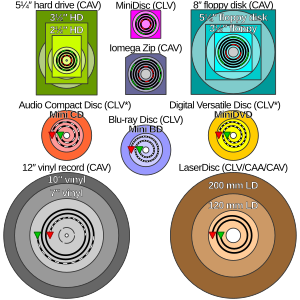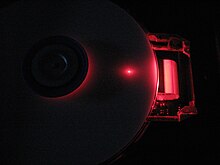
A | B | C | D | E | F | G | H | CH | I | J | K | L | M | N | O | P | Q | R | S | T | U | V | W | X | Y | Z | 0 | 1 | 2 | 3 | 4 | 5 | 6 | 7 | 8 | 9
 | |
 The data side of a DVD manufactured by Sony DADC | |
| Media type | Optical disc |
|---|---|
| Encoding | DVD-ROM and DVD-R(W) use one encoding, DVD-RAM and DVD+R(W) uses another |
| Capacity | 4.7 GB (single-sided, single-layer – common) 8.5 GB (single-sided, double-layer) 9.4 GB (double-sided, single-layer) 17.08 GB (double-sided, double-layer) Up to four layers are possible in a standard form DVD. |
| Read mechanism | 300–650 nm laser, 10.5 Mbit/s (1×) |
| Write mechanism | 650 nm laser with a focused beam using more power than for reading, 10.5 Mbit/s (1×) |
| Standard | DVD Forum's DVD Books[1][2][3] and DVD+RW Alliance specifications |
| Developed by | Sony Panasonic Philips Toshiba |
| Dimensions | Diameter: 12 cm (4.7 in) Thickness: 1.2 mm (0.047 in) |
| Weight | 16 grams (0.56 oz) |
| Usage | Home video, Computer data storage |
| Extended from | LaserDisc Compact disc |
| Extended to | |
| Released | November 1, 1996 (Japan)[4] January 1997 (CIS and other Asia) March 24, 1997 (United States)[5][6][7] March 1998 (Europe)[8] February 1999 (Australia/New Zealand) |
| Optical discs |
|---|
The DVD (common abbreviation for digital video disc or digital versatile disc)[9][10] is a digital optical disc data storage format. It was invented and developed in 1995 and first released on November 1, 1996, in Japan. The medium can store any kind of digital data and has been widely used to store video programs (watched using DVD players), software and other computer files. DVDs offer significantly higher storage capacity than compact discs (CD) while having the same dimensions. A standard single-layer DVD can store up to 4.7 GB of data, a dual-layer DVD up to 8.5 GB. Variants can store up to a maximum of 17.08 GB.[11]
Prerecorded DVDs are mass-produced using molding machines that physically stamp data onto the DVD. Such discs are a form of DVD-ROM because data can only be read and not written or erased. Blank recordable DVD discs (DVD-R and DVD+R) can be recorded once using a DVD recorder and then function as a DVD-ROM. Rewritable DVDs (DVD-RW, DVD+RW, and DVD-RAM) can be recorded and erased many times.
DVDs are used in DVD-Video consumer digital video format and less commonly in DVD-Audio consumer digital audio format, as well as for authoring DVD discs written in a special AVCHD format to hold high definition material (often in conjunction with AVCHD format camcorders). DVDs containing other types of information may be referred to as DVD data discs.
Etymology
The Oxford English Dictionary comments that, "In 1995, rival manufacturers of the product initially named digital video disc agreed that, in order to emphasize the flexibility of the format for multimedia applications, the preferred abbreviation DVD would be understood to denote digital versatile disc." The OED also states that in 1995, "The companies said the official name of the format will simply be DVD. Toshiba had been using the name 'digital video disc', but that was switched to 'digital versatile disc' after computer companies complained that it left out their applications."[12]
"Digital versatile disc" is the explanation provided in a DVD Forum Primer from 2000[13] and in the DVD Forum's mission statement, which the purpose is to promote broad acceptance of DVD products on technology, across entertainment, and other industries.[14]
Because DVDs became highly popular for the distribution of movies in the 2000s, the term DVD became popularly used in English as a noun to describe specifically a full-length movie released on the format; for example the sentence to "watch a DVD" describes watching a movie on DVD.[15]
History
Development and launch

* Some CD-R(W) and DVD-R(W)/DVD+R(W) recorders operate in ZCLV, CAA or CAV modes, but most work in constant linear velocity (CLV) mode.

Released in 1987, CD Video used analog video encoding on optical discs matching the established standard 120 mm (4.7 in) size of audio CDs. Video CD (VCD) became one of the first formats for distributing digitally encoded films in this format, in 1993.[16] In the same year, two new optical disc storage formats were being developed. One was the Multimedia Compact Disc (MMCD), backed by Philips and Sony (developers of the CD and CD-i), and the other was the Super Density (SD) disc, supported by Toshiba, Time Warner, Matsushita Electric, Hitachi, Mitsubishi Electric, Pioneer, Thomson, and JVC. By the time of the press launches for both formats in January 1995, the MMCD nomenclature had been dropped, and Philips and Sony were referring to their format as Digital Video Disc (DVD).[17][18]
On May 3, 1995, an ad hoc, industry technical group formed from five computer companies (IBM, Apple, Compaq, Hewlett-Packard, and Microsoft) issued a press release stating that they would only accept a single format.[19][20] The group voted to boycott both formats unless the two camps agreed on a single, converged standard. They recruited Lou Gerstner, president of IBM, to pressure the executives of the warring factions. In one significant compromise, the MMCD and SD groups agreed to adopt proposal SD 9, which specified that both layers of the dual-layered disc be read from the same side—instead of proposal SD 10, which would have created a two-sided disc that users would have to turn over. Philips/Sony strongly insisted on the source code, EFMPlus, that Kees Schouhamer Immink had designed for the MMCD, because it makes it possible to apply the existing CD servo technology. Its drawback was a loss from 5 to 4.7 Gbyte of capacity. Philips and Sony decided that it was in their best interests to end the format war, and on September 15, 1995, agreed to unify with companies backing the Super Density Disc to release a single format, with technologies from both.[21][22]
As a result, the DVD specification provided a storage capacity of 4.7 GB (4.38 GiB)[a] for a single-layered, single-sided disc and 8.5 GB (7.92 GiB) for a dual-layered, single-sided disc.[23] The DVD specification ended up similar to Toshiba and Matsushita's Super Density Disc, except for the dual-layer option. MMCD was single-sided and optionally dual-layer, whereas SD was two half-thickness, single-layer discs which were pressed separately and then glued together to form a double-sided disc.[18]
Philips and Sony decided that it was in their best interests to end the format war, and on September 15, 1995[24] agreed to unify with companies backing the Super Density Disc to release a single format, with technologies from both. After other compromises between MMCD and SD, the group of computer companies won the day, and a single format was agreed upon. The computer companies also collaborated with the Optical Storage Technology Association (OSTA) on the use of their implementation of the ISO-13346 file system (known as Universal Disk Format) for use on the new DVDs. The format's details were finalized on December 8, 1995.[25]
In November 1995, Samsung announced it would start mass-producing DVDs by September 1996.[26] The format launched on November 1, 1996, in Japan, mostly with music video releases. The first major releases from Warner Home Video arrived on December 20, 1996, with four titles being available.[b][4] The format's release in the U.S. was delayed multiple times, from August 1996,[27] to October 1996,[28] November 1996,[29] before finally settling on early 1997.[30] Players began to be produced domestically that winter, with March 24, 1997, as the U.S. launch date of the format proper in seven test markets.[c][6][31] Approximately 32 titles were available on launch day, mainly from the Warner Bros., MGM, and New Line libraries,[32][d] with the notable inclusion of the 1996 film Twister.[33] However, the launch was planned for the following day (March 25), leading to a distribution change with retailers and studios to prevent similar violations of breaking the street date.[34] The nationwide rollout for the format happened on August 22, 1997.[35][better source needed]
DTS announced in late 1997 that they would be coming onto the format. The sound system company revealed details in a November 1997 online interview, and clarified it would release discs in early 1998.[36] However, this date would be pushed back several times before finally releasing their first titles at the 1999 Consumer Electronics Show.[37]
In 2001, blank DVD recordable discs cost the equivalent of $27.34 US dollars in 2022.[38][39]
Adoption

Movie and home entertainment distributors adopted the DVD format to replace the ubiquitous VHS tape as the primary consumer video distribution format.[40]
Immediately following the formal adoption of a unified standard for DVD, two of the four leading video game console companies (Sega and The 3DO Company) said they already had plans to design a gaming console with DVDs as the source medium.[41] Sony stated at the time that they had no plans to use DVD in their gaming systems, despite being one of the developers of the DVD format and eventually the first company to actually release a DVD-based console.[41] Game consoles such as the PlayStation 2, Xbox, and Xbox 360 use DVDs as their source medium for games and other software. Contemporary games for Windows were also distributed on DVD. Early DVDs were mastered using DLT tape,[42] but using DVD-R DL or +R DL eventually became common.[43] TV DVD combos, combining a standard definition CRT TV or an HD flat panel TV with a DVD mechanism under the CRT or on the back of the flat panel, and VCR/DVD combos were also available for purchase.[44]
For consumers, DVD soon replaced VHS as the favored choice for home movie releases. In 2001, DVD players outsold VCRs for the first time in the United States. At this time 1 in 4 American households owned a DVD player.[45] By 2007, about 80% of Americans owned a DVD player, a figure that had surpassed VCRs and was also higher than personal computers or cable television.[46]
Specifications
The DVD specifications created and updated by the DVD Forum are published as so-called DVD Books (e.g. DVD-ROM Book, DVD-Audio Book, DVD-Video Book, DVD-R Book, DVD-RW Book, DVD-RAM Book, DVD-AR (Audio Recording) Book, DVD-VR (Video Recording) Book, etc.).[1][2][3] DVD discs are made up of two discs; normally one is blank, and the other contains data. Each disc is 0.6 mm thick, and are glued together to form a DVD disc. The gluing process must be done carefully to make the disc as flat as possible to avoid both birefringence and "disc tilt", which is when the disc is not perfectly flat, preventing it from being read.[47][48]
Some specifications for mechanical, physical and optical characteristics of DVD optical discs can be downloaded as freely available standards from the ISO website.[49] There are also equivalent European Computer Manufacturers Association (Ecma) standards for some of these specifications, such as Ecma-267 for DVD-ROMs.[50] Also, the DVD+RW Alliance publishes competing recordable DVD specifications such as DVD+R, DVD+R DL, DVD+RW or DVD+RW DL. These DVD formats are also ISO standards.[51][52][53][54]
Some DVD specifications (e.g. for DVD-Video) are not publicly available and can be obtained only from the DVD Format/Logo Licensing Corporation (DVD FLLC) for a fee of US$5000.[55][56] Every subscriber must sign a non-disclosure agreement as certain information on the DVD Books is proprietary and confidential.[55]
Double-sided discs
Borrowing from the LaserDisc format, the DVD standard includes DVD-10 discs (Type B in ISO) with two recorded data layers such that only one layer is accessible from either side of the disc. This doubles the total nominal capacity of a DVD-10 disc to 9.4 GB (8.75 GiB), but each side is locked to 4.7 GB. Like DVD-5 discs, DVD-10 discs are defined as single-layer (SL) discs.[49]
Dual-layer discs
DVD hardware accesses the additional layer (layer 1) by refocusing the laser through an otherwise normally-placed, semitransparent first layer (layer 0). This laser refocus—and the subsequent time needed to reacquire laser tracking—can cause a noticeable pause in A/V playback on earlier DVD players, the length of which varies between hardware.[57] A printed message explaining that the layer-transition pause was not a malfunction became standard on DVD keep cases. During mastering, a studio could make the transition less obvious by timing it to occur just before a camera angle change or other abrupt shift, an early example being the DVD release of Toy Story.[58] Later in the format's life, larger data buffers and faster optical pickups in DVD players made layer transitions effectively invisible regardless of mastering.[citation needed]
Dual-layer DVDs are recorded using Opposite Track Path (OTP).[59]
Combinations of the above
The DVD Book also permits an additional disc type called DVD-14: a hybrid double-sided disc with one dual-layer side, one single-layer side, and a total nominal capacity of 12.3 GB.[60] DVD-14 has no counterpart in ISO.[49]
Both of these additional disc types are extremely rare due to their complicated and expensive manufacturing.[60] For this reason, some DVDs that were initially issued as double-sided discs were later pressed as two-disc sets.
![]() Note: The above sections regarding disc types pertain to 12 cm discs. The same disc types exist for 8 cm discs: ISO standards still regard these discs as Types A–D, while the DVD Book assigns them distinct disc types. DVD-14 has no analogous 8 cm type. The comparative data for 8 cm discs is provided further down.
Note: The above sections regarding disc types pertain to 12 cm discs. The same disc types exist for 8 cm discs: ISO standards still regard these discs as Types A–D, while the DVD Book assigns them distinct disc types. DVD-14 has no analogous 8 cm type. The comparative data for 8 cm discs is provided further down.
DVD recordable and rewritable


HP initially developed recordable DVD media from the need to store data for backup and transport.[61][failed verification] DVD recordables are now also used for consumer audio and video recording. Three formats were developed: DVD-R/RW, DVD+R/RW (plus), and DVD-RAM. DVD-R is available in two formats, General (650 nm) and Authoring (635 nm), where Authoring discs may be recorded with CSS encrypted video content but General discs may not.[62]
Dual-layer recording
Dual-layer recording (occasionally called double-layer recording) allows DVD-R and DVD+R discs to store nearly double the data of a single-layer disc—8.5 and 4.7 gigabyte capacities, respectively.[63] The additional capacity comes at a cost: DVD±DLs have slower write speeds as compared to DVD±R.[64] DVD-R DL was developed for the DVD Forum by Pioneer Corporation; DVD+R DL was developed for the DVD+RW Alliance by Mitsubishi Kagaku Media (MKM) and Philips.[65]
Recordable DVD discs supporting dual-layer technology are backward-compatible with some hardware developed before the recordable medium.[65]
Capacity
| Designation | Sides | Layers (total) |
Diameter (cm) |
Capacity | ||
|---|---|---|---|---|---|---|
| (GB) | ||||||
| DVD-1[68] | SS SL | 1 | 1 | 8 | 1.46 | |
| DVD-2 | SS DL | 1 | 2 | 8 | 2.65 | |
| DVD-3 | DS SL | 2 | 2 | 8 | 2.92 | |
| DVD-4 | DS DL | 2 | 4 | 8 | 5.31 | |
| DVD-5 | SS SL | 1 | 1 | 12 | 4.70 | |
| DVD-9 | SS DL | 1 | 2 | 12 | 8.54 | |
| DVD-10 | DS SL | 2 | 2 | 12 | 9.40 | |
| DVD-14[60] | DS SL+DL | 2 | 3 | 12 | 13.24 | |
| DVD-18 | DS DL | 2 | 4 | 12 | 17.08 | |


| Designation | Sides | Layers (total) |
Diameter (cm) |
Capacity | ||
|---|---|---|---|---|---|---|
| (GB) | ||||||
| DVD-R | SS SL (1.0) | 1 | 1 | 12 | 3.95 | |
| DVD-R | SS SL (2.0) | 1 | 1 | 12 | 4.70 | |
| DVD-RW | SS SL | 1 | 1 | 12 | 4.70 | |
| DVD+R | SS SL | 1 | 1 | 12 | 4.70 | |
| DVD+RW | SS SL | 1 | 1 | 12 | 4.70 | |
| DVD-R | SS DL | 1 | 2 | 12 | 8.50 | |
| DVD-RW | SS DL | 1 | 2 | 12 | 8.54 | |
| DVD+R | SS DL | 1 | 2 | 12 | 8.54 | |
| DVD+RW | SS DL | 1 | 2 | 12 | 8.54 | |
| DVD-RAM | SS SL | 1 | 1 | 8 | 1.46* | |
| DVD-RAM | DS SL | 2 | 1 | 8 | 2.47* | |
| DVD-RAM | SS SL (1.0) | 1 | 1 | 12 | 2.58 | |
| DVD-RAM | SS SL (2.0) | 1 | 1 | 12 | 4.70 | |
| DVD-RAM | DS SL (1.0) | 2 | 1 | 12 | 5.15 | |
| DVD-RAM | DS SL (2.0) | 2 | 1 | 12 | 9.39* | |
| Type | Sectors | Bytes | kB | MB | GB |
|---|---|---|---|---|---|
| DVD-R SL | 2,298,496 | 4,707,319,808 | 4,707,320 | 4,707 | 4.7 |
| DVD+R SL | 2,295,104 | 4,700,372,992 | 4,700,373 | 4,700 | 4.7 |
| DVD-R DL | 4,171,712 | 8,543,666,176 | 8,543,666 | 8,544 | 8.5 |
| DVD+R DL | 4,173,824 | 8,547,991,552 | 8,547,992 | 8,548 | 8.5 |
DVD drives and players
DVD drives are devices that can read DVD discs on a computer. DVD players are a particular type of devices that do not require a computer to work, and can read DVD-Video and DVD-Audio discs.
Transfer rates

Read and write speeds for the first DVD drives and players were 1,385 kB/s (1,353 KiB/s); this speed is usually called "1×". More recent models, at 18× or 20×, have 18 or 20 times that speed. For CD drives, 1× means 153.6 kB/s (150 KiB/s), about one-ninth as swift.[68][69]
| Drive speed (not rotations) | Data rate | ~Write time (minutes)[e] | Revolutions per minute (constant linear velocity, CLV)[70][71][f] | ||
|---|---|---|---|---|---|
| Mbit/s | MB/s | Single-Layer | Dual-Layer | ||
| 1× | 11 | 1.4 | 57 | 103 | 1400 (inner) 580 (outer)[69] |
| 2× | 22 | 2.8 | 28 | 51 | 2800 (inner) 1160 (outer) |
| 2.4× | 27 | 3.3 | 24 | 43 | 3360 (inner) 1392 (outer) |
| 2.6× | 29 | 3.6 | 22 | 40 | 3640 (inner) 1508 (outer) |
| 3× | 33 | 4.1 | 19 | 34 | 4200 (inner) 2320 (outer) |
| 4× | 44 | 5.5 | 14 | 26 | 5600 (inner) 2900 (outer) |
| 6× | 67 | 8.3 | 9 | 17 | 8400 (inner) 3480 (outer) |
| 8× | 89 | 11.1 | 7 | 13 | 4640 (CAV; no longer uses pure CLV) |
| 10× | 111 | 13.9 | 6 | 10 | 5800 |
| 12× | 133 | 16.6 | 5 | 9 | 6960 |
| 16× | 177 | 22.2 | 4 | 6 | 9280 |
| 18× | 199 | 24.9 | 3 | 6 | 10440 |
| 20× | 222 | 27.7 | 3 | Zdroj:https://en.wikipedia.org?pojem=Digital_video_disc||
